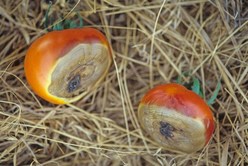
soils are derived from limestone, which is partially made up of calcium. So, what causes blossom end rot?
Actually, there are a number of possible causes, especially on tomatoes. Let's look at some of
them.
- Tomato tops often outgrow the root system during cooler spring weather. As long as it is cool,
with the calcium it carries — goes to the leaves and the fruit is bypassed. The plant responds
with new root growth and the condition corrects itself after a couple of weeks.
- Heavy fertilization, especially with ammonium forms of nitrogen, can encourage this condition.
competes with calcium for uptake. If blossom-end rot has been a perpetual problem, try using calcium nitrate (15-0-0) as your fertilizer.
- Anything that disturbs roots such as hoeing too deep can encourage blossom-end rot. Mulching
- Inconsistent watering can be a factor. Keep soil moist but not waterlogged.
Mulching can help by moderating moisture levels over time. You should also avoid damaging roots and watch fertilization. But there are some years you do everything right and the condition shows up due to the weather. In such cases, remember that blossom-end rot is a temporary condition, and plants should come out of it in a couple of weeks. You may want to pick off affected fruit to encourage new fruit formation.
Soils with adequate calcium will not benefit from adding additional calcium. If your soil is
deficient in this nutrient, add 1 pound gypsum per 100 square feet. Gypsum is calcium sulfate
and will not affect pH. Though calcium raises pH, sulfate lowers it and the two cancel each
other out. Even if not needed, gypsum will not hurt anything.
We have also found that spraying plants with calcium doesn't work. The fruit's waxy surface
doesn't allow absorption of the material and calcium does not move from the leaves to the fruit.
Last of all, there are years you can do everything right and still have blossom end rot. As
mentioned above, the condition should correct itself in a couple of weeks. (Ward Upham)
 RSS Feed
RSS Feed
